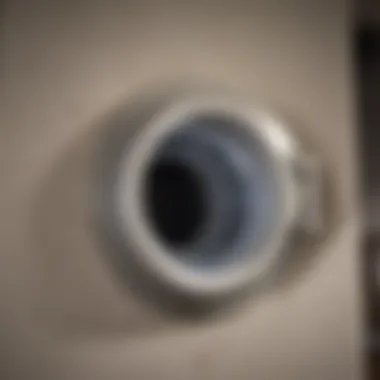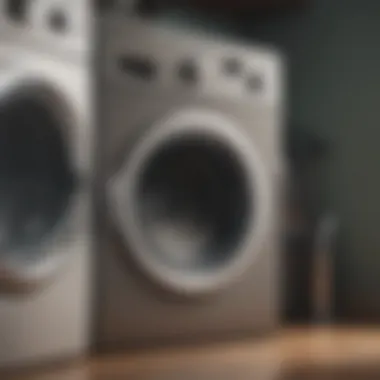Optimal Dryer Vent Cleaning Frequency Explained


Intro
Dryer vent cleaning is a crucial yet often overlooked aspect of home maintenance. Despite being a common household task, many homeowners may not fully understand its importance or how frequently it should be done. By keeping dryer vents clean, one can enhance the efficiency of the appliance while significantly reducing the risk of fire hazards. In this article, we will delve into the factors influencing the frequency of dryer vent cleaning and offer insights on best practices to maintain a safe and efficient home environment.
Factors Affecting Cleaning Frequency
The necessity for cleaning dryer vents can vary based on several factors. Recognizing these elements can help homeowners determine an appropriate cleaning schedule.
- Usage Level: Homes with high laundry demands may require more frequent cleaning. If your household does several loads each week, consider cleaning the vent at least once a year.
- Fuzzy and Lint Build-Up: Lint builds up quickly in dryer vents. Visible lint buildup in the dryer or around the vent hood is a strong indicator that it is time to clean.
- Dryer Location: If the dryer is located far from the exterior vent, the buildup can occur more easily due to longer duct lengths. Thus, homes with longer ducts should schedule cleanings more often.
"A clogged vent may lead to exhaust gases entering the home and increasing the risk of dryer fires."
Understanding these factors allows individuals to create a more tailored approach to maintenance.
Industry Recommendations
Industry experts recommend cleaning dryer vents at least once a year. However, this can vary based on individual circumstances. Here are some key recommendations:
- Annual Inspections: Even if one does not notice immediate problems, an annual inspection can reveal hidden issues that may not be visible to the untrained eye.
- Professional Services: Hiring professionals for cleaning can be beneficial. They use specialized tools and techniques that ensure thorough cleaning and check for potential issues.
- Self-Maintenance Tips: Regularly checking for lint buildup in both the dryer and vent hood can also help maintain cleanliness. Keeping the lint trap clean after each use is essential to avoid excessive clogs.
Ending
The importance of regular dryer vent cleaning cannot be overstated. It plays a key role in safety and efficiency in every household. By following industry recommendations and understanding factors influencing vent maintenance, homeowners can enjoy peace of mind and prolong the life of their dryers. Maintaining a clean dryer vent not only protects your home but also ensures that your appliance works effectively, contributing to a sustainable living environment.
Prolusion
Dryer vent cleaning is an essential practice for maintaining not only the efficiency of your dryer but also for ensuring safety in your home. Many homeowners overlook this task, often assuming that their appliance will function effectively without regular maintenance. This belief can lead to significant hazards, making it vital to stay informed about how often to clean dryer vents.
Additionally, various factors influence how often vents should be cleaned. Household size, the type of dryer you own, and even what materials you dry can greatly impact lint accumulation. It’s essential to consider these aspects while determining a cleaning schedule.
In this article, we will delve deeper into the various factors that dictate dryer vent cleaning frequency. We will explore industry recommendations, common signs indicating the need for more frequent cleaning, and best practices for maintaining dryer vents. By uncovering these aspects, homeowners can better safeguard their homes while ensuring their appliances operate at peak efficiency.
"Regular maintenance of dryer vents is not just a recommendation; it’s a necessity for safety and efficiency."
In summary, understanding the frequency and importance of dryer vent cleaning is crucial for every homeowner. It is not only about avoiding potential mishaps but also about enhancing the overall performance of the dryer. An informed approach to dryer vent maintenance can result in a safer and more efficient household.
Importance of Dryer Vent Maintenance
Maintaining a clean dryer vent is crucial for several reasons. Firstly, it enhances the efficiency of the dryer. When ventilation is obstructed, the dryer has to work harder to expel warm air. This contributes to longer drying times and increased energy consumption. Over time, neglecting the vents can result in elevated utility bills and excessive wear on the appliance.
Secondly, a clean dryer vent promotes safety in the home. Lint buildup is the primary culprit behind dryer-related fires. According to the U.S. Fire Administration, more than 15,000 fires each year are linked to dryers. Many of these incidents can be avoided with proper maintenance. It is vital to ensure that the entire venting system, including ducts and vents, remains free from obstruction.


Moreover, regular dryer vent cleaning prolongs the lifespan of the dryer itself. Increased strain on the dryer from clogged vents may lead to more frequent repairs or even a total appliance failure. Homes with maintained dryer vents can save more in the long run compared to those facing constant repairs.
In summary, dryer vent maintenance is not just about efficiency but also about safety and longevity.
Understanding Dryer Lint and Its Risks
Understanding dryer lint is essential in recognizing its potential hazards. Dryer lint is a combination of tiny fibers that shed from clothing and fabrics during the drying process. Over time, this lint accumulates not only in the lint trap but also within the dryer vent itself. Lint is highly flammable, making it a significant fire hazard.
The risk increases considerably if vents are long or have multiple bends that can trap lint. When lint builds up, airflow diminishes. This results in the dryer overheating, which raises the likelihood of igniting the accumulated lint. Furthermore, moisture retained in the lint can create an ideal environment for mold growth, impacting air quality inside the home.
Common Issues Caused by Clogged Vents
Clogged dryer vents lead to various complications beyond just safety concerns. Here is a look at some common issues:
- Increased Drying Times: If the vent is blocked, clothes require longer to dry, leading to frustration and inconvenience.
- Overheating: Clogged vents cause the dryer to become excessively hot, which can trigger an automatic shutoff or worse, damage the machine.
- Higher Energy Costs: With longer drying cycles, energy consumption rises. Homeowners often notice unexpected spikes in their utility bills.
- Clothes Damage: Overheating can damage fabrics, leading to fading and wear that may mean replacing clothes sooner than expected.
Industry Recommendations for Cleaning Frequency
Homeowners need to be aware of these guidelines as they provide a framework for when to clean dryer vents. Regular maintenance not only extends the life of the dryer but also minimizes the dangers associated with dryer lint buildup. By adhering to established recommendations, residents can uphold safety standards in their homes.
Annual Cleaning Recommendations
Most industry experts advocate for an annual cleaning of dryer vents. This guideline may seem straightforward, but its implications can be profound. Annual cleaning helps prevent lint accumulation, which can obstruct airflow and lead to overheating. Over time, this hazard can escalate to a fire risk, which is a significant concern for homeowners.
Different organizations, such as the U.S. Fire Administration, emphasize the importance of routine maintenance. They suggest that an annual inspection should check for clogs and ensure the vent system is functioning correctly.
Some specific benefits of annual inspections include:
- Improved Dryer Efficiency: A clear vent allows for optimal airflow, reducing drying times and energy consumption.
- Prevention of Appliance Damage: Regular cleaning can prevent wear and tear on dryer components that might occur when the machine is overworked due to poor airflow.
- Peace of Mind: Knowing that your dryer is well-maintained can relieve concerns regarding potential hazards associated with a malfunctioning appliance.
Signs That Indicate More Frequent Cleaning
While annual recommendations provide a baseline, some situations may necessitate more frequent dryer vent cleaning. Homeowners should be vigilant for certain signs that indicate a blockage or lint buildup.
Here are key indicators:
- Longer Drying Times: If clothes take longer than usual to dry, it may be a sign that the vent is clogged and airflow is restricted.
- Burning Smell: A burning odor while the dryer is in use is an immediate red flag and should prompt an urgent inspection.
- Heat Around the Dryer: If the dryer feels excessively hot, it suggests that lint may be preventing proper air circulation.
- Lint Accumulation: Noticeable lint buildup around the dryer’s door or vent exit is a strong indication that cleaning is overdue.
- Frequent Usage: Homes with heavy usage, especially those with larger families or more loads, should consider cleaning every six months instead of annually.
Regular inspection combined with immediate action on these signs can greatly enhance safety and efficiency.
Factors Influencing Cleaning Frequency
Understanding the factors that influence the frequency of dryer vent cleaning is crucial for homeowners. These elements can significantly affect efficiency, safety, and longevity of the dryer. Identifying specific characteristics of one's household, equipment, and materials used enhances decision-making regarding maintenance schedules.


Household Size and Usage Patterns
Households with larger families typically use their dryers more frequently. This increased usage leads to a higher buildup of lint and debris within the vent, necessitating more regular cleaning. For example, a family of four may find that lint accumulates faster than in a single-person household. On average, families prone to frequent laundry days should consider a cleaning every six months rather than annually.
Usage patterns also play a role. If a household is involved in activities that generate more laundry, such as sports or frequent hosting, the dryer will work harder. Observing these patterns and adapting maintenance schedules accordingly is key to preventing blockages.
Type of Dryer and Venting System
The type of dryer directly impacts cleaning frequency. Standard vented dryers generally require more maintenance compared to energy-efficient, ventless models. While vented dryers expel hot air and lint outside, ventless dryers recycle air within the unit, potentially accumulating moisture and lint in different ways.
Additionally, the design of the venting system influences how often cleaning is needed. Longer duct runs with multiple bends create more opportunity for lint accumulation. Homeowners should examine their system, as those with complex venting may need to clean more frequently than those with straight, short ducts.
Cloth Material and Drying Frequency
The type of fabric being laundered plays a significant role in how often the dryer vent should be cleaned. For instance, heavier fabrics such as towels and blankets produce more lint than lighter clothing. If heavy items are frequently dried, this can clog the vent quickly, requiring more attention.
Moreover, the drying frequency reflects on maintenance. Homes that routinely wash and dry large amounts of laundry from clothing and linens will likely see an increased need for vent cleaning. Color choices and physical characteristics of fabrics can also influence this, as darker fabrics tend to attract and hold more lint.
In summary, homeowners should assess their specific situation to determine the most appropriate cleaning frequency. By taking into account household size, dryer type, and the kinds of materials being dried, one can adopt a proactive approach to dryer vent maintenance. This will not only ensure efficiency but also reduce potential hazards linked to neglect.
Potential Consequences of Neglecting Maintenance
Neglecting dryer vent maintenance can lead to significant consequences. It is crucial to understand these potential issues to emphasize the importance of regular cleaning. Proper upkeep of dryer vents can enhance safety and preserve the efficiency of appliances. When homeowners are unaware of the dangers, the risks multiply.
Fire Hazards Related to Blocked Vents
One of the most serious consequences of ignoring dryer vent cleaning is the increased risk of fire. Lint and other debris accumulate in the vent over time. This buildup creates a highly flammable situation. According to the National Fire Protection Association, failure to clean the dryer vent is a leading cause of home clothes dryer fires. The hot air that cannot escape due to a blockage causes overheating. Inadequate air circulation can ignite lint, posing severe hazards to home safety.
Regular inspection and cleaning can minimize these risks. Homeowners should check vents after every drying cycle. If they notice a burning smell or smoke, it is crucial to shut off the dryer immediately and seek professional help. Maintaining clear dryer vents improves airflow and reduces the possibility of fires.
Energy Efficiency Issues
Blocked dryer vents also lead to energy efficiency problems. When air cannot flow freely, dryers must work harder to dry clothes, wasting energy. This can lead to increased utility bills. According to the U.S. Department of Energy, inefficient dryers increase energy consumption, thus impacting environmental sustainability negatively.
Homeowners may notice longer drying times and increased energy consumption if they do not clean their vents regularly. The added strain on the appliance can shorten the lifespan of the dryer, resulting in costly repairs or replacements down the line. Cleaning out the vent can restore the appliance’s efficiency and improve performance.
The benefits of regular dryer vent maintenance are clear; increased safety and improved energy efficiency help protect both your home and your wallet.
Recognizing the potential consequences of neglecting dryer vent maintenance is essential. Homeowners must take proactive steps to ensure their vents are clean and functional. Addressing these issues can lead to safer homes and reduced energy costs.
Best Practices for Dryer Vent Maintenance
Effective maintenance of dryer vents can significantly enhance their efficiency and lifespan. Understanding best practices is vital for homeowners who wish to prevent hazards and maintain optimal performance in their drying systems. Regular inspections and cleanings can mitigate risks, promote energy savings, and increase the lifespan of both appliances and vents. By implementing specific strategies, one can ensure safe and efficient dryer operation.


DIY Inspection Techniques
Performing do-it-yourself inspections can be a straightforward yet essential part of dryer vent maintenance. Here are some techniques that can aid in these inspections:
- Visual Checks: Regularly examine the dryer vent for any kinks or loose connections. Look for lint buildup, especially around the outside vent opening.
- Airflow Testing: After running the dryer for about 15 minutes, check if air is flowing freely through the vent. If airflow feels restrained or the lint trap fills up too quickly, it might be a sign of a blockage.
- Vacuuming: Use a vacuum cleaner with a hose attachment to suck out visible lint or debris from the vent’s external opening. This can be an effective way to deal with minor blockages early.
- Lint Trap Maintenance: Always clean the lint trap after each use. A clean lint trap promotes airflow and reduces the risk of fire hazards.
When to Seek Professional Help
While DIY inspection techniques are useful, certain situations require the expertise of professionals. Understanding when to seek help can prove invaluable for maintaining safe and effective dryer vent systems. Consider contacting a technician in the following scenarios:
- Persistent Blockages: If airflow issues continue even after regular cleaning, this could indicate a more significant blockage deeper in the vent system.
- Extensive Lint Accumulation: If lint is frequently building up in the ductwork, it can signify that a thorough cleaning is necessary.
- Strange Noises or Odors: Unusual sounds from the dryer or unpleasant odors can be warning signs of malfunction or potential fire hazards.
- Annual Professional Cleaning: Many industry experts recommend an annual professional cleaning, particularly for heavy users or larger households. This ensures that the entire venting system is free from lint buildup and functioning correctly.
"Regular dryer vent maintenance not only helps avoid fire hazards but also improves the energy efficiency of your dryer."
By adhering to these best practices, homeowners can effectively maintain dryer vents, creating a safer and more efficient laundry environment.
Frequency Guidelines for Different Scenarios
Understanding the correct frequency for dryer vent cleaning is essential for preventing hazards and maintaining optimal dryer performance. Various factors influence the need for maintenance, including household size, usage patterns, and the presence of pets. Each scenario requires tailored guidelines, ensuring safety and efficiency.
For Average Households
For the average household, the general recommendation is to clean the dryer vent at least once a year. This is suitable for families that use their dryer moderately. In these homes, lint build-up tends to occur at a manageable rate. Timely cleaning ensures that the dryer operates effectively and minimizes fire risks. Here are some key reasons why this frequency is advisable:
- Prevention of Fire Hazards: Regular cleaning reduces the risk of lint igniting due to heat.
- Improved Efficiency: A clean vent allows for proper airflow, leading to quicker drying times.
- Cost-Effectiveness: Maintaining the dryer ensures longevity, saving costs on repairs or replacements.
For Larger Families
Larger families typically generate more laundry. As a result, their dryers are in use more frequently. For this scenario, it is prudent to consider cleaning the vent two or even three times a year. Increased usage leads to faster accumulation of lint, which can block the vent. The issues larger families may face include:
- Increased Risk of Clogs: More frequent use elevates the chances of lint build-up in the vent.
- Higher Energy Bills: Inefficient drying leads to increased energy consumption.
- Maintenance Needs: Addressing vent clogs promptly may prevent breakdowns and extend dryer life.
For Homes With Pets
Homes with pets have additional lint sources due to pet hair. For these households, the recommended cleaning frequency is at least twice a year or more, depending on the number and type of pets. Here are important considerations for pet-friendly homes:
- Pet Hair as a Fire Hazard: Fur can mix with dryer lint, creating flammable clogs.
- Allergies and Air Quality: Poorly maintained vents can contribute to indoor air quality issues, especially for residents with sensitivities.
- Frequent Maintenance as a Must: Given the added complexity, homeowners should monitor the dryness of their clothes and sought signs of blockage.
Regular upkeep is crucial for safe and efficient dryer operation, regardless of household size or conditions.
By adhering to these frequency guidelines, different households can effectively manage dryer maintenance, enhancing both safety and efficiency.
End
In understanding the importance of dryer vent cleaning frequency, we face several significant elements. First and foremost, regular maintenance of dryer vents is not merely a routine task; it is a crucial aspect of home safety and efficiency. Neglecting to clean these vents regularly can lead to hazardous situations, such as house fires caused by lint buildup. The statistics indicate that inadequate cleaning is a primary contributor to such dangers.
Moreover, the frequency of dryer vent cleaning plays a direct role in energy efficiency. When vents are clogged, dryers must work harder, ultimately leading to higher energy costs and wear on the machine. This is something every homeowner should be aware of, as it can lead to increased utility bills over time.
Consideration of factors like household size and the types of clothes regularly dried also influences how often one should clean the vents. By understanding these variables, residents can make informed decisions. For instance, larger families or homes with pets may require more frequent maintenance. Adopting a proactive approach can help avert numerous problems down the line.







